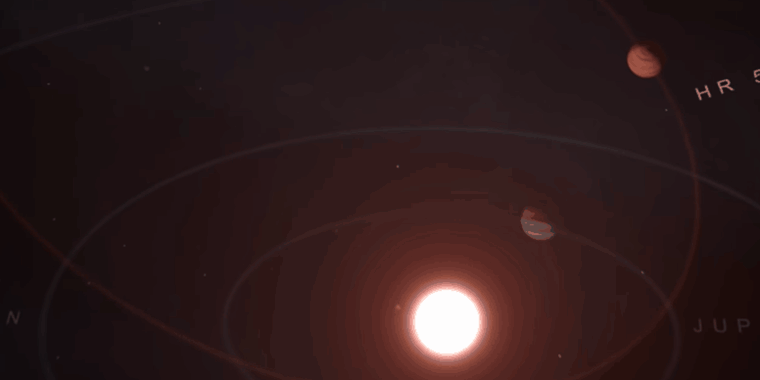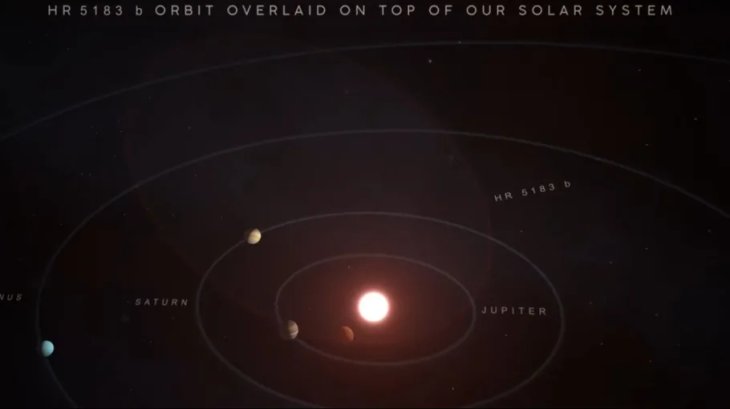This Giant Exoplanet Strangely Orbits Around Its Star
Anil - Sep 24, 2019

Named HR 5183b, the exoplanet with strange behaviors is three times more massive than Jupiter, and its orbit particularly shaped like an egg.
- The First Space Hotel In The World Will Welcome 400 Guests
- Startup Builds Vehicle With Soviets Tech To Collect Space Garbage
- World's First Space Hotel To Begin Construction In 2025 With Rooms For 400 Guests
A new planet with unique characteristics and strange behaviors than ever has been recently discovered by astronomers. Named HR 5183b, the exoplanet is three times more massive than Jupiter, and its orbit particularly shaped like an egg. Although many other gigantic elliptical planets have been found, they all feature the close proximity to their stars. Scientists have explained such discovery in a paper that will be published in The Astronomical Journal in the coming time.

The method in which scientists use to detect the planet is through radial velocity. This procedure makes use of the swaying motion of the parent stars obtained by the gravitational force of the planets that orbit the star. According to scientists, the collecting data process over the duration of the orbital periods is not easy, as it takes years, such as Neptune with 165 years. For HR 5183b, researchers have yet acquired sufficient data about its orbital period although they have been continuously observing it for more than 20 years. It is estimated to take 45 to 100 years for the planet to complete its orbit movement. More interestingly, the planet was discovered not because of its orbital period but for its peculiar movement.
The California Planet Search is considered to be one of the few organizations that have been able to observe planets for decades. This is critically important for the recognition of exoplanets with long orbital duration through radial velocity. To detect this mysterious planet, scientists had to research the data of three separate observatories. As clarified by the Head of The California Planet Search, Andrew W. Howard, this planet tends to wander along its off-center orbit to the direction of the star HR 5183’s planetary system. It also accelerates gradually while coming closer to the star.

As such, scientists recognized that the planet moved further from the star after approaching it. Also according to the cosmo principles, new planets often have flat and circular orbits due to the formation of material disks left behind after a star’s formation. As for HR 5183, the reason for its eccentric orbit is largely due to the possibility of gravitational external force caused by celestial bodies. Scientists have speculated that there was once a planet with similar size located near HR 5183. And when the two planets have enough distance, they would force each other away, leading to the extreme eccentric orbit of HR 5183b.
Featured Stories

Features - Jul 01, 2025
What Are The Fastest Passenger Vehicles Ever Created?

Features - Jun 25, 2025
Japan Hydrogen Breakthrough: Scientists Crack the Clean Energy Code with...

ICT News - Jun 25, 2025
AI Intimidation Tactics: CEOs Turn Flawed Technology Into Employee Fear Machine

Review - Jun 25, 2025
Windows 11 Problems: Is Microsoft's "Best" OS Actually Getting Worse?

Features - Jun 22, 2025
Telegram Founder Pavel Durov Plans to Split $14 Billion Fortune Among 106 Children

ICT News - Jun 22, 2025
Neuralink Telepathy Chip Enables Quadriplegic Rob Greiner to Control Games with...

Features - Jun 21, 2025
This Over $100 Bottle Has Nothing But Fresh Air Inside

Features - Jun 18, 2025
Best Mobile VPN Apps for Gaming 2025: Complete Guide

Features - Jun 18, 2025
A Math Formula Tells Us How Long Everything Will Live

Features - Jun 16, 2025
Comments
Sort by Newest | Popular